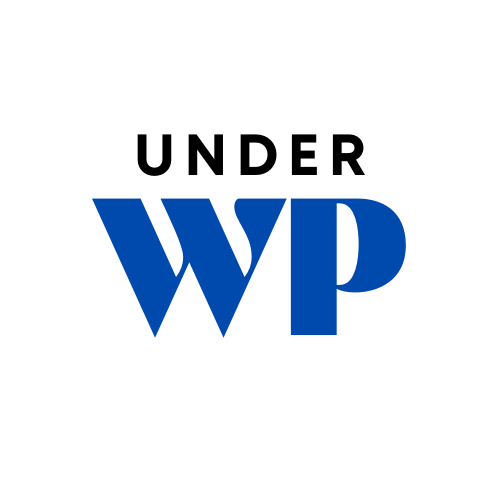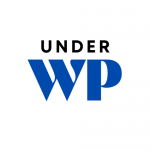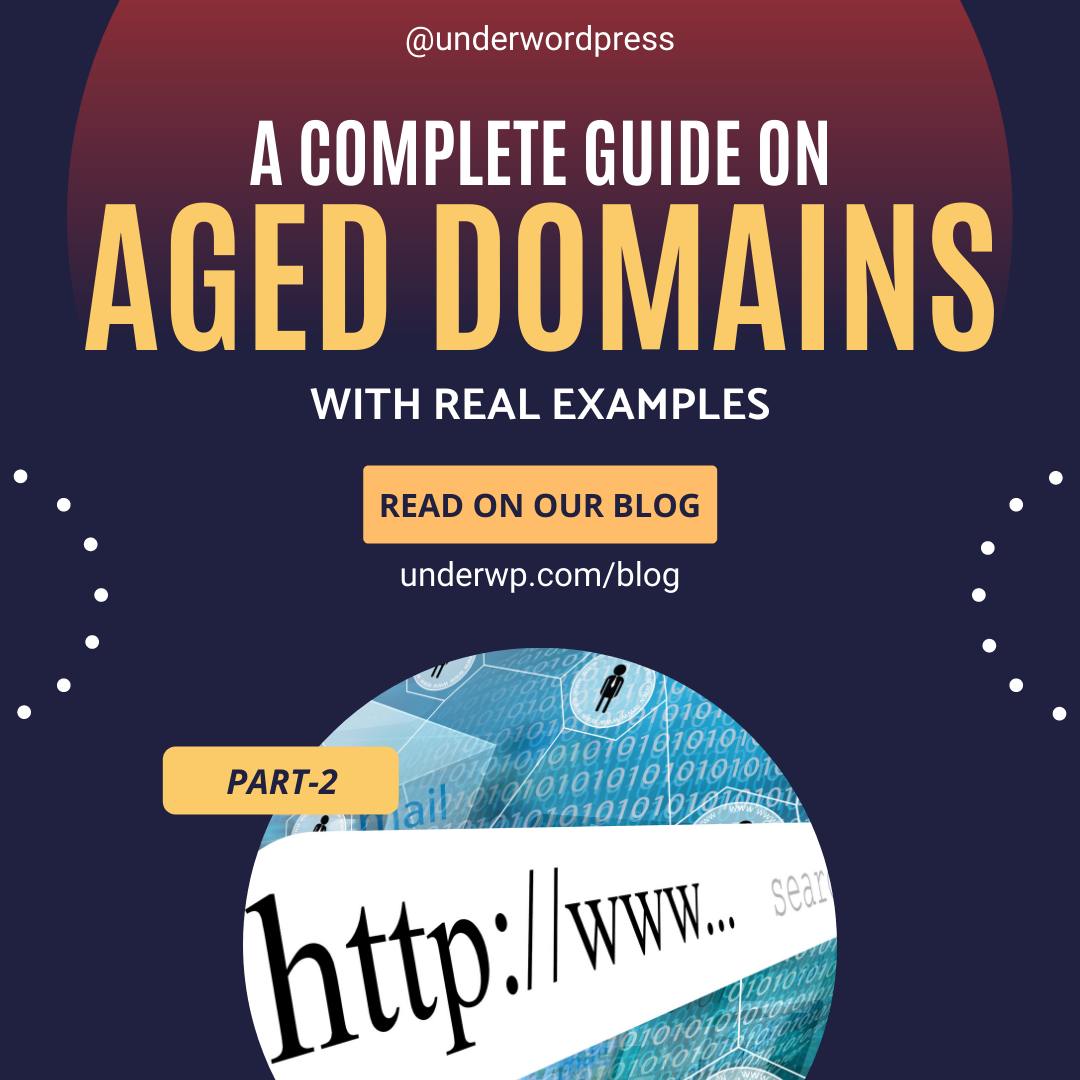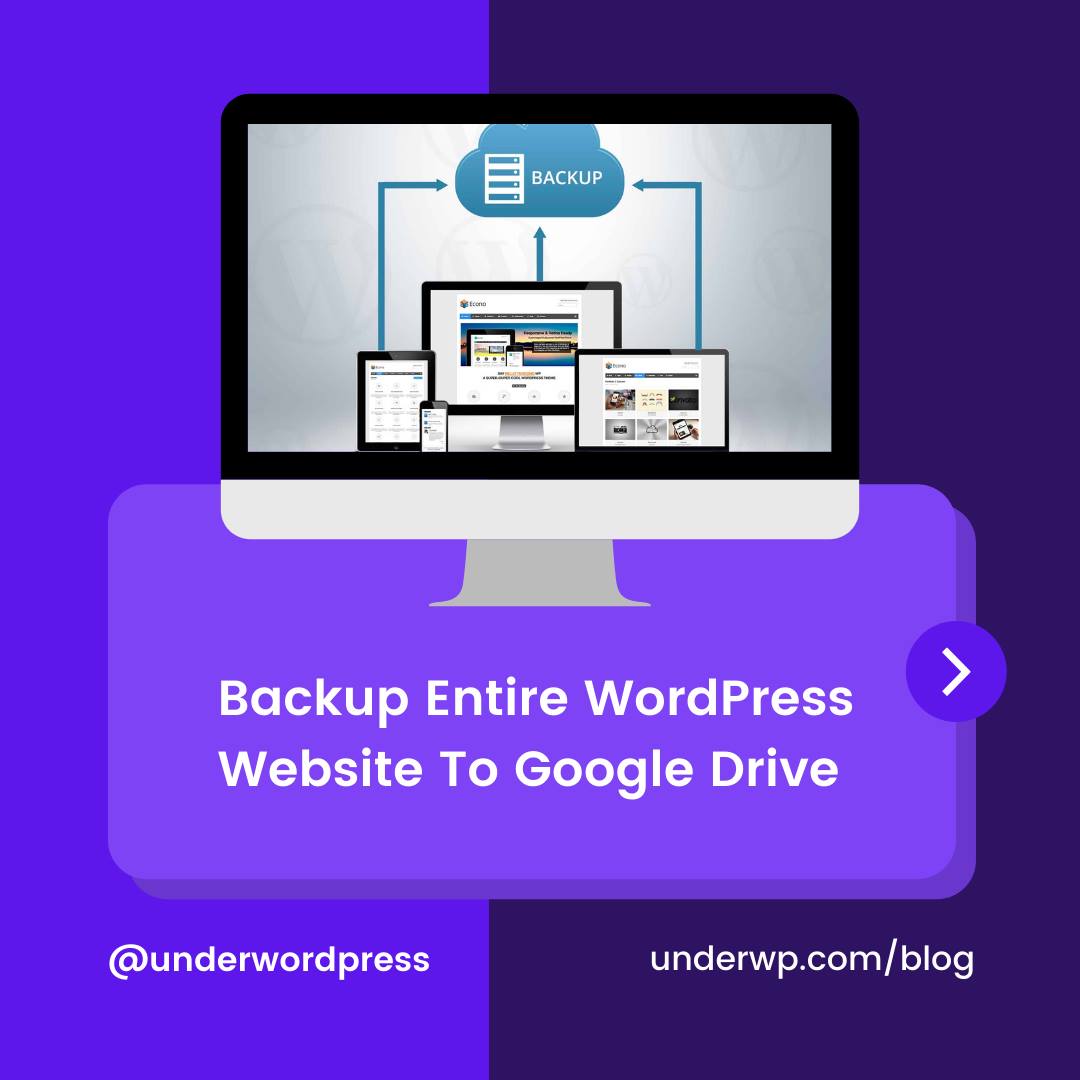Continuing from the previous part of this blog post series, here we are back with a more interesting article about aged domains.
In this post, you will see a real case study and how we helped one of our clients build a $1.5 million worth niche website.
Read the previous part of this blog post series here: https://underwp.com/a-complete-buyers-guide-on-aged-domains-with-examples-part-1/
Ranking keywords
You want to go back and look at the keywords that it's ranked for. You can go and do that in ahrefs
Again you want to avoid keywords related to porn, gambling, payday loans, etc and you also want to avoid.
If it's a dog domain but then you're ranking for loads of golf articles, etc. then again you can see that this is just a red flag to say.
This domain does not have consistent history.
We don't want to mess with that we just want something that's kind of solid and has remained the same over time.
Ideally what we're really looking for is a genuine domain from a genuine business that just acquired links organically.
High Level SEO metrics
This is something I think a lot of people might fall into the trap of when they're looking for an aged domain.
They just literally check that they are on the high-level metrics and they don't go through any of the other due diligence we've spoken about.
Tools like ahrefs and semrush try to give us an indication of the authority of a site.
We use these to give us a good idea but it's definitely used in conjunction with all of the other stuff that we've spoken about and we're also checking for anomalies in those metrics.
For example, if the site has a really high DR or a really low DR or whatever and the number of referring domains just doesn't seem to match up.
Maybe it's got a couple of thousand referring domains. It's only a DR 10 then probably that is referring to other spam websites.
We'll need at least to be looked at to see why this semi-referring remains and the DR is so low.
If you need help with link building for your website. Check out our Services section in the menu above.
When we look at trust flow, we quite like trust flow but it generally works better at the higher end.
If a site's got a really high trust flow like 30 or 40 is really good and generally we find that that's genuine like that. This means that the site is pretty good.
But at the other end of the scale when you're looking at sites that don't have many backlinks in their backlink profile that trust flow score can be skewed
If you already got sort of 20 backlinks then those might be fine and genuine backlinks. But there's only so much data for majestic in this case to like work from, so that could just be skewed a little bit.
We tend to just give ourselves a hard line on anything below five. We just avoid but we check them all to be honest and URL rating from ahrefs.
Domain authority page authority from and then trust flow citation flow from majestic. The other factors like the DR score can be gained.
There are ways to make a domain look like it's got a higher Domain Rating Score than the genuinely has in terms of its authority.
Quite often you can spot this.
Also, check if its DR has grown really rapidly over time.
If it's growing really quickly again you can see that it hasn't kind of grown more organically over time then that might be something to show that that's not a real authority score, that's something that's been gained.
Trademarks
You want to make sure that the domain doesn't have any trademarks because this can be huge.
You could invest loads of time building our site or money as well and find that the domain has a trademark and you get a letter through the door one day telling you that you can no longer use that domain because it's trademarked.
And then you're kind of starting again or looking for another domain to kind of transfer your content over to.
But it's really important to kind of check this upfront. You don't want to get caught up in that down the road.
There are databases, there's one in the UK there's one in the US.
Sometimes there might be trademarks but it seems like that trademark doesn't quite fit with the type of business that you're creating.
In terms of a blog it might be rated for example to an e-commerce store specifically, it's like to do with storefronts and not online sales and that kind of thing.
So it can be a bit of a grey area. If you've got any doubts definitely recommend employing the services of a professional to clear that up for you and make sure that you're not infringing on any trademarks with your plans for the domain.
Case Study – A customer
I've got a case study for you.
It's a customer who started with us around December 2020 and they're very new to the website investing space.
But i think they did a lot of reading and a lot of research. They were really keen to get started on a website portfolio which kind of earned them money over time.
We launched a number of different sites for foreign on aged domains but very quickly some domains just take off.
One site was clearly showing a lot more potential than any of the other domains. This domain like you could argue, he kind of overpaid for the domain.
He paid quite a lot, he did have a little bit of prestige associated with it in that it was connected to a famous person or at least the family member of a famous person and therefore it had some really good backlinks because of that connection
But at the same time, the authority of the domain was decent but it wasn't huge. The DR was 30+.
This domain had some really good potential real early on so we decided to double down and grow the site aggressively and spend less time and investment on the other domains that we're working on.
Going back to what I said about aged domains not being a silver bullet and still having to do the work right work to make any site successful.
UnderWP's Raider SEO Strategy
This is something that we do with a lot of our aged domains.
We use what we call UnderWP's Raider SEO strategy. It is a term that we coined that is essentially a repeatable process for competitor research.
The way that works is that we take all of the metrics for these industry metrics here so UR, DR, DA, PA, Trust Flow, Citation Flow, etc.
You go down like a little rabbit hole, you'll find a competitor then you'll find their competitors and then their competitors and you can kind of build-out like a real big list and the bigger the list the better.
Because this gives us more opportunity.
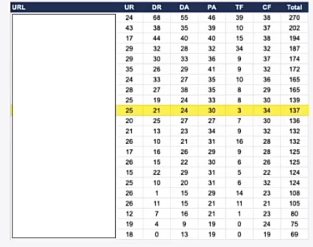
What we then do is that we're going to add up all of these metrics for each of the domains that we found and this kind of gives us a kind rudimentary idea of where we exist in the competitor landscape versus other sites in the space.
In this case, the yellow line is the site that we're referring to.
We will look at all of these. We kind of ignore the ones that are above us in authority and we look at the ones that are below us with the idea being that you know if these sites are perceived to have a weaker authority than us then we should be able to rank for the same keywords that they're ranking for.
The rating aspect of this technique comes from going through each of the competitors and working out what pages and what keywords they're ranking for and kind of pulling them out and putting them into our content plan.
As I said, if they can rank for these terms and rank these articles, we should be able to rank as well.
If you're working in SEO for any period of time you'll know that using traditional kind of keyword research methods, you'll find that 20% or 80% of your traffic comes from twenty per cent of your pages.
And the other 80% kind of go by the wayside and that's just the way it is.
That's just like what we accept we can't rank every page. And it's definitely gonna be weighted towards a smaller proportion of the pages in that same.
But using this technique we kind of get better results because if you think about it all of those weak competitors have already done that hard work for us they've already told us what 20 pages they can already rank for.
So if we take all of those 20 from all of those competitors then we stand a much better chance of being able to rank for them too.
And that's kind of proven true in that we tend to get a higher hit rate in what we can rank for.
Let me know in the comments below if you want to learn more about this technique and we will make a different post about it sometime.
This technique we don't just use for aged domains but also for any clients that we work with that has established sites.
Obviously, this doesn't work for a brand new domain because you are at the bottom and there are no weak competitors at that point in time.
But for any established type, this is something you can use.
So, as part of this process, we had our initial domain and as I mentioned at the beginning of this post series that you can also use other aged domains to power up the domain that you're working on.
Essentially, what I'm saying is that if you have your own domain which maybe is a DR-15, you can go ahead and purchase other aged domains and then 301 redirect those domains into your domain.
And what you'll see then is that all of the backlinks are then kind of attributed to the domain that you're working on kind of raises the authority.
For the site that you're working on now you need to be super careful doing this. You don't wanna be redirecting any links to the homepage, as we mentioned with the anchors before.
We've seen some issues where if you're redirecting in a more powerful domain than the main domain that you're working on, you can mess up the anchor profile because instead of the anchors being the brand of the actual domain you're working on now they can suddenly become the brand the anchor of the brand that you're redirecting in.
That can kind of cause all sorts of problems.
Avoid scenarios like that.
The best thing to do is to create a separate page.
I will talk more about this later in this post.
For this customer, we initially redirected in two domains and we saw that the referring domains go up and we saw traffic go up and it was successful.
At this point so successful that the customer got kind of addicted to doing this and was purchasing the relevant domains over time and we ended up redirecting six domains over a six month period.
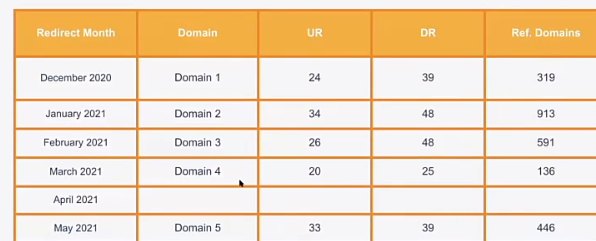
Again you need to be careful with doing this but you just need to make sure you're doing it the right way.
This happens all the time right, businesses acquire other businesses, they merge sites together so it's not uncommon to see this kind of practice take place.
If you look at huge corporate sites like Microsoft, Apple, you'll see hundreds of domains kind of redirected into them.
So it does happen, it's just that you want to make sure that it's sensible for what you've got.
And because this domain had a reasonable authority already and it was gaining authority over time, we kind of rolled these in.
Over a few months, we found that this has been a really effective search ranking tactic.
We kind of suggested that we don't want to go keep going too much further than this to start looking unnatural and we stopped at six domains here.
And the way we did the redirecting is that for any page that had a lot of backlinks, we would completely rewrite and recreate that article.
The way we think about it is if a page has over 10 links associated with it then we will completely rewrite that article and 301 redirect the old article to the new article.
If a domain has two or three links associated with it then what we'll do is we'll just manually 301 redirect that to another relevant page on the site or to a category page on the site.
And then if it's got less than that then we tend to redirect it to a page which just acts like a notification that we've acquired this domain and it's now part of the site that we're working on.
And then redirect all of the other pages and the whole page into that page.
For this customer, we did it slightly differently so his site has become very much an authority style and it's very much niche down on a specific area.
But you can kind of break that down into categories.
Some of the domains that we bought were based on specific categories. We added new categories to this design.
What we did is we would create like a skyscraper articles something that's four thousand plus words that broadly covers all of the topics and all of the posts within the category that we've either acquired and moving over that are already on the site.
In that skyscraper article, we would put lots of links out to all of the other blog posts on the site.
We found that it helped with the legit legitimacy of the acquisition.
A step further the client also released a press release announcing that he had acquired these domains as well.
We're just trying to do everything that we can to make it look as legitimate and as credible as possible.
As we were over this site, we were looking to build a huge site by doing something like a press release for a couple of hundred dollars is well worth doing. Just to give you a little bit of an idea.
Content and Timeline
About the number of words that we're adding to this and over what period of time.

I've only kind of got the data up until July last year. This is kind of where we just created the case study it.
It was launched with 150,000 words in December and we did the first redirects at the end of December over time you know we added in all of those six aged domains and at the same time, we just kept adding large chunks of content over time.
The great thing about this business model in terms of website investing is that you only have to put money or time in at the start.
Once the site starts making money you can just kind of reinvest all of that money into just growing the site growing your asset bigger.
You don't have to invest any new money over time and this is one of the absolutely great things about this asset class and website investing and essentially this is what this client was doing.
He was at the beginning to be fair. He was probably putting his own money in but very quickly it was paying for itself.
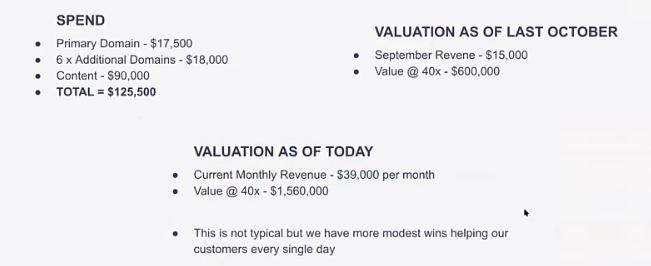
As we go over the numbers now, let's say this client bought this domain it was $17,500, which is a huge sum.
But when you see at the earnings, you can see that anyone would have paid that had they known what the potential was for this site.
We added 6 additional age domains overtime for another $18,000 and the constant value came to ninety thousand dollars.
So the total spending for this customer over that period of time was about $1,25,000.
As of last October, which is when this case study we were kind of drawing up this case study.
The site was earning around $15,000 which meant the site was worth around six hundred thousand dollars at a 40x multiplier.
I don't have any more data about the number of words that are added and all that kind of thing.
What I can tell you is that as of today the site has been making just shy of $40,000 a month and at 40 x valuation is 1.5 million, 1.56 million in terms of valuation.
Final Words
Aged domains can be extremely effective in building powerful sites quickly.
Aged domains are going to help you skip the Google sandbox and avoid you having that waiting time.
They're still crazy undervalued for what you get.
That's only going to go up over time I think the cost of demands is just going to continue to increase. But right now get in, they're super value for money.
However, you need to be really careful about what you're looking for.
Due diligence is absolutely key. You're not gonna be successful if you fail to do your diligence correctly.
No domains are a good choice for repurposing. I mentioned the restaurant domain and then repurpose that to a food site and lots of little loopholes.
You just need to make sure that you're trying to match as closely as possible what the domain was used for and historically and building a portfolio is always good.
It lowers the risk if there's ever a google update and one of your sites get hit. So you want to do that but also just because we have varying success and varying results with aged domains.
If you build out a portfolio that increases the chance you're just going to hit one of those runaway winners and generally, we recommend that if you've got a portfolio and one's just clearly showing to be the winner why reinvest in the others.
Put mostly resources into the winner's offer.
